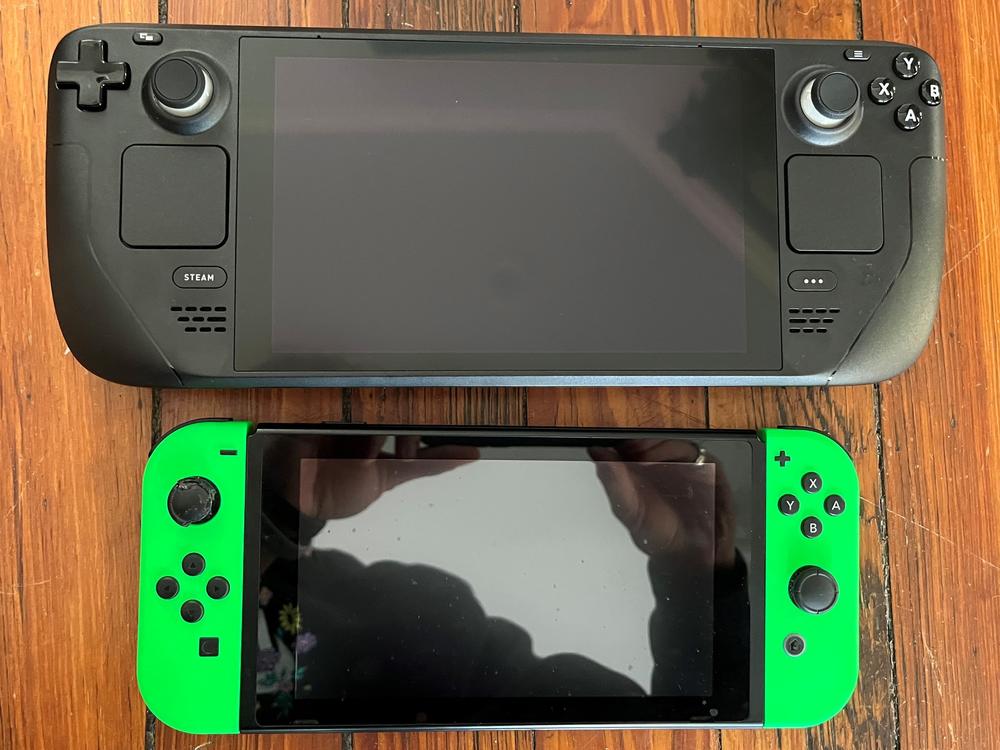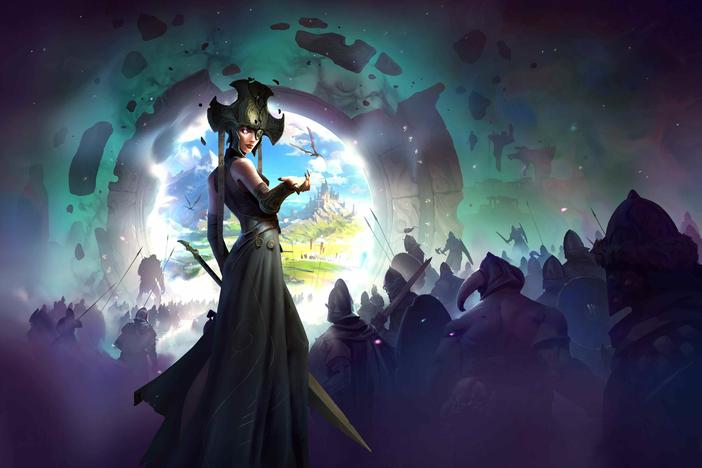Section Branding
Header Content
Review: Heavy, buggy Steam Deck wins over a Nintendo Switch fan
Primary Content
Like millions of other gamers, I've spent the last few weeks drooling over the new hit Elden Ring. Glued to the couch, I'll load up my PS5 and anxiously explore The Lands Between. It's so thrilling that stepping away to participate in this boring thing called "real life" can be a drag.
While I have a Nintendo Switch brimming with indie games, the 5-year old console hasn't kept up with the technological demands of new blockbusters like Elden Ring. But what if I didn't need to step away from a cutting-edge console? What if I had all the luxuries of a gaming PC wherever I went?
Breaking into an elite niche
PC gaming is traditionally the province of hardcore enthusiasts with money to burn. Such aficionados invest many hundreds — even thousands — of dollars into custom desktops, equipped with pricey monitors, mice and keyboards festooned with RGB lights.
But when Valve announced the Steam Deck in July 2021, I saw an opportunity. I had games through Steam — the largest PC gaming store — but my laptop couldn't run them smoothly, and it was far more enjoyable to play on PS5 or Nintendo Switch.
Less than a year later, the Steam Deck arrived at my doorstep, (almost) ready for whatever games I wanted to download. And despite some glaring technical issues and hardware weaknesses (we'll get to that), the Steam Deck has quickly become a staple in my gaming arsenal.
Valve boasts that the Steam Deck can run the 30,000+ games from the Steam store, which is remarkable considering you could play Deathloop on the train. Even the most expensive Steam Deck ($649) costs much less than the average gaming PC. What dedicated gamer wouldn't want access to thousands of portable games for that much?
Switching loyalties
It's a proposition that could entice people away from the Nintendo Switch. But Jason Schreier, video games reporter for Bloomberg, says that's not likely.
"Nintendo will never have to worry as long as they have Mario, Zelda, Pokémon, and all their other franchises, which are some of the biggest things on the planet."
Valve isn't focused on stealing Nintendo fans, and it's unlikely that the Steam Deck will sell the 100 million+ units that Nintendo did with the Switch. Consumers won't be able to get the Steam Deck from any retailer — you can only order directly from Valve.
"It's already pretty niche," says Schreier. "Unlike the Switch, which you can just pick up at Target or Walmart."
Breaking into the console market is ridiculously difficult. For decades, it's been dominated by the same three companies: Nintendo, Sony, and Microsoft. Even Google, with their endless resources, failed to make a high-selling console. But Valve seems confident that dedicated gamers will empty their wallets.
"The Steam Deck is meant for the person with a huge backlog of Steam games," says Jason Schreier, "And now they can play them on the go."
But there's a catch: Not all games on the Steam store have been "verified" for Steam Deck compatibility. If you happen to get a hold of one — which is nearly impossible without a preorder — a little yellow icon indicates that you'll have to adjust controller inputs to make the game playable. Luckily, the Steam Deck has countless customizations to meet a game's needs, including built-in trackpads.
Trackpads? On a handheld console?
Yes, and they're Valve's way of being a little more friendly to fast-paced first-person shooters like Call of Duty or Apex Legends. Sitting below the joysticks, they're intended to mimic the finesse a traditional mouse would give to these games. Plus, they add a new way to navigate what at its core is a portable computer with underlying functionality similar to a Chromebook.
That's right; while the Steam Deck is built for gaming, it can still function as a desktop computer. Hold down the power button to switch to a desktop mode with a Linux operating system and internet browser. With a mouse and keyboard connected through the USB-C port, you can check your email, watch Netflix or even write a review of the Steam Deck!
But despite the Steam Deck's versatility, it isn't a perfect machine — at least not yet. A high-pitched fan starts whirring non-stop as soon as you launch a game. The finicky touchscreen will freeze up occasionally. While Valve has been pushing out frequent updates, these inconveniences may frustrate early adopters.
It's also heavy — far outweighing the Nintendo Switch. The Switch (with JoyCons attached) comes in at 0.88 lbs, while the Steam Deck is twice as weighty at a whopping 1.65 lbs. I found that the most comfortable way to use the Steam Deck was to place a pillow on my lap and hold the console there.
It's also a pain to lug around. Both thicker and heavier than the Switch, the Steam Deck takes up a lot of space while stored in its carrying case. Plopping it into my backpack left me little room to throw in extra gym clothes, a water bottle, or books. Unfortunately, making the Steam Deck a part of your daily commute may prove difficult. Despite this, the Steam Deck is shaping up to be a popular portable console; the waitlist extends through the Fall of 2022. And it's changed my habits as well.
Before receiving my Steam Deck, I felt left out of PC gaming. My 3 year-old laptop isn't designed for it, and launching Steam didn't bring me as much joy as turning on my Switch. But now PC gaming is a treat. I can look past the console's blemishes knowing that an incredible array of games await me. And while Nintendo may be banking on their first-party hits, they no longer hold a monopoly on portable indie games. My Switch has literally collected dust since I got the Steam Deck, and until there's a major Nintendo release, it's likely to stay that way.
Keller Gordon is a columnist for Join The Game. Find him on Twitter: @kelbot_
NPR received a Steam Deck from Valve for the purposes of this review.
Copyright 2022 NPR. To see more, visit https://www.npr.org.
Bottom Content







